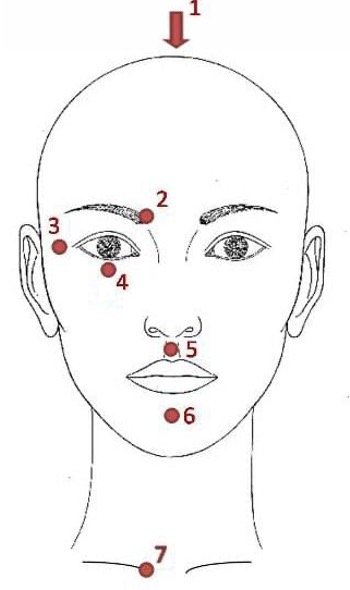Tapping Qigong
Every part of you is you
Massaging acupuncture points by simply tapping them with your fingers while maintaining an awareness of breath and mind is a powerful way to practice mind-body healing. The image (from the public domain) shows points on the face and head that you can tap.
Often a desire to heal can spring from a desire to rid ourselves of something bothersome like stress or pain or irritating symptoms. Over time, it is not just the body that suffers, but the mind suffers as well, and so the mind wants to eliminate what is bothersome. This is understandable. However, there is another way to work with what is bothersome, which is to transform it. Gentle practices like Tapping Qigong can soothe the suffering and even transform it. The suffering transforms as a result of everything transforming, including and especially yourself. You can transform a state of distress into a state of peace when you are in a state of remembering your natural state. Your natural state is that part of you that is always well and always “in there somewhere” in the middle of whatever you are going through. Your natural state is basically the potential for you to be well and whole, and so it is always present. Any practice of conscious breathing and moving can be used to make contact with the part of yourself that is always well. All forms of Qigong that emphasize breath, mind, and body engagement, including Tapping Qigong, can bring you back to your natural state. In consciously returning to your natural state, what you are doing is encouraging energy to flow in balance and harmony within you and all around you.
Tapping Qigong, like all forms of Qigong, can help you return to your natural state.
Once you learn a few Tapping Qigong sequences, Tapping Qigong can be part of the self-healing tools you use and share regularly.
Tapping Qigong involves using your hands and fingers or simple massage tools for massaging or tapping the body. Think of it also as contacting the body’s energy system, the meridians, or “inner rivers of energy,” and encouraging energy to flow freely so that obstructions get cleared or areas of deficiency get replenished. The theory in Traditional Chinese Medicine is that the inner rivers of energy (the meridians) are in regular communication with one another at any given moment. It is a dynamic system of communication. Sometimes through sudden injury or traumas that can happen little by little and over time, the communications in the energy system are disrupted. These disruptions can then amount to weakness, distress, or illness. Tapping acupuncture points with mind and breath focus can restore the sense of flow in the energy system.
Tapping as a self-massage practice can be done in a variety of ways. Because tapping or pounding the body stimulates the flow of energy through the energy channels (the meridians), to tone the body, calm the mind, and restore and maintain balance in the human energy system, it can be a powerful and effective practice that helps you transform yourself and your situation.
There are three routines that I practice, and each one has its place in a Qigong practice. These are described briefly below.
Tapping the Body with Pai Da Practice
The first point tapping practice I will describe is known as Pai Da. This routine is generally performed after strenuous exercise or before doing extended seated or still practices that can be considered deep mind journeys. The goal of the Pai Da exercises is to give a sense of embodiment, which translates to a feeling of safety and groundedness. Pai Da practice can be a way of fully animating the body with life and energy, which some people may experience as feelings aliveness in the body and clarity in the mind. In Pai Da tapping, you strike the body with light fists or open palms or brushing strokes. One great example of a Pai Da tapping movement is known by the name, “Dropping the Post.” In the Dropping the Post exercise, the heels are raised and then tapped (dropped) onto the floor or the ground firmly with an audible and satisfying exhalation. Dropping the Post several times can give you a sense of connection to the very earth! Pai Da is a practice that prepares you for interacting and moving in the world, which can mean caring for and regarding others or sometimes advocating or standing up for yourself when necessary. Pai Da exercises are great warm-up exercises to wake up the body and bring it fully into living and being.
Tapping Mind and Body with the Emotional Freedom Technique
The second body point tapping Qigong exercise is what is popularly known as Emotional Freedom Technique (EFT). The basic premise of this technique is to tap a set of points while focusing on the energies of the heartmind, meaning emotions, thoughts, and feelings. Energy that is out of balance in the human system will manifest as physical symptoms and very likely also manifest as emotions and thoughts of distress that can affect mood, energy levels, and beliefs. In EFT, you tap acupuncture points lightly with your fingertips, and in so doing give yourself an acupressure treatment that can balance the whole body, the whole energy system. The practice has been widely popularized by contemporary healers and coaches, used by psychologists with their clients and, and also researched by scientists.
The basic points in the EFT sequence included are as follows:
Small Intestine point SI3 (side of the hand)
Urinary Bladder point B2 (nose side of the eyebrow)
Gallbladder point G1 (side of the eye)
Stomach point St2 (under the eye)
Governing Vessel GV26 (under the nose)
Conception Vessel CV24 (above chin, under mouth)
Kidney point K27 (nob of collarbone)
Spleen Sp21 (under the arm)
Governing Vessel GV20 (top of head)
The fingers and hands also have points and can be stimulated as you tap. I like to remind students that every part of you is you. When you approach the points of you (the points of your body) with respect and attention, as you do with EFT, something will likely shift. It is also helpful to think of all the points and meridians as being interconnected and communicating with one another via the vast network that is human energy system. The energy of the whole system can potentially flow freely, and tapping the points encourages this.
“You cannot change one thing without changing everything,” is an important teaching in Traditional Chinese Medicine regarding the study of the points, and so this simple tapping sequence can in theory change everything.
EFT uses the basic tapping sequence noted above, and as you tap the points you also speak truths and encouragements to yourself out loud or in your mind. This creates a way to listen to the heartmind, which means listening to the feelings, the emotions and thoughts that can be part of distress. There are many techniques for speaking as you tap (many EFT “scripts” exist), and this is helpful up to a point. With EFT you want to be able to listen deeply to your own experience, your own feelings and stories. The deep listening is what transforms the energies of distress. Using your own words will be the most accurate and effective in this regard, but it does take a little while to get used to doing the tapping and speaking and breathing and focusing all at once! So it is helpful to go through group tapping, witness examples of other people tapping, and use scripts (like using recipes in the kitchen) to help you understand and also experience what happens when you combine mindful tapping and deep listening. This is something you can practice regularly. As with all Qigong forms, practice and repetition are the things that help you see results.
Tapping the Timeless and Formless with Primordial Tapping Qigong
The last form of Tapping Qigong I practice involves tapping the body along a set of points that were identified by the ancients as places within the human energy system that are associated with timeless and boundless aspects of oneself. Primordial Tapping Qigong involves approaching yourself and your situation with reverence and humility. After you have done some purification rituals like EFT or Pai Da, your body and mind can be quiet and still enough for you to fully bring your awareness to that part of you that is purely spirit. This is what you do in Primordial Tapping Qigong.
In Primordial Tapping Qigong, you tap the following points in this order:
Bubbling Well Kidney point K1 (on the sole of the foot, just in front of the arch and in the center of the ball of the foot)
Governing Vessel point GV20 (top of the head)
Yintang (Third Eye) extra point (just between and slightly above the eyebrows)
Taiyang (Great Sun) extra point (the temple)
Yin Jiao Governing Vessel point GV28 (the meeting point of the gums and the upper lip)
Sauce Receptacle Conception Vessel point CV24 (above chin, under mouth)
Sea of Tranquility Conception Vessel point CV17 (center of breastbone)
Center of Power Conception Vessel point CV12 (solar plexus)
Spirit Gate Conception Vessel point CV8 (belly button)
Outer Pass Triple Burner point TB5 (outer forearm, three finger widths from wrist fold)
Inner Pass Pericardium point P6 (inner forearm, three finger widths from the inside of the wrist)
Spirit Gate Heart point H7 (point where wrist and side of palm meet on the little finger side)
Palace of Toil Pericardium point P8 (center of palm)
The set of points are slightly different from the EFT points set, but both sets are intended to balance the energy system.
However, the intent in Primordial Tapping Qigong is not to directly transform specific emotions and energy as you would do in EFT as much as it is to increase the connection to spirit by feeling the energy flow of your system as a flow within a greater flow of spirit. The intention with Primordial Tapping Qigong is to use the exercise of tapping the body with breath and mind focus to embody spiritual concepts such as the Eternal Self, Infinite Life, Infinite Love, Boundless Qi, and Infinite Healing. Like EFT, Primordial Tapping Qigong is a deep form of listening, but instead of listening to your heartmind (your thoughts and feelings and experiences), you are listening to life and existence and your relationship to the greater whole. Once connected and elevated like this, the spiritual energy rises and causes human fear and distress to diminish on their own. Healing then arises sometimes completely and permanently. Times I have practiced Primordial Tapping Qigong have been in moments of ceremony and in a community of shared intention. The ritual of Primordial Tapping Qigong is offered to sanctify life, and so it is a great honor to be part of a Primordial Tapping Qigong group. During a Primordial Tapping Qigong ritual and ceremony, a shared sense of being outside of time together can arise. It is a ritual that reminds us that we are more than the physical body and more than our thoughts, feelings and experiences. We are part of something larger and connected to all that is. Sensing the Vast Mystery of Existence, where transformation is always possible and always happening, can feel oceanic. It can also be profoundly healing.
Tapping into Power
These three approaches to Tapping Qigong address the whole person, body, mind, and spirit through contacting the meridians as gateways to healing and transformation. Opening to the possibility that the ailing and unbalanced body and mind can heal and return to a state of balance and harmony can be a process that takes commitment, time, and repetition. Any kind of Tapping Qigong may serve to chip away at the sense of limitation inherent in states of illness and distress so that wholeness can be revealed.


